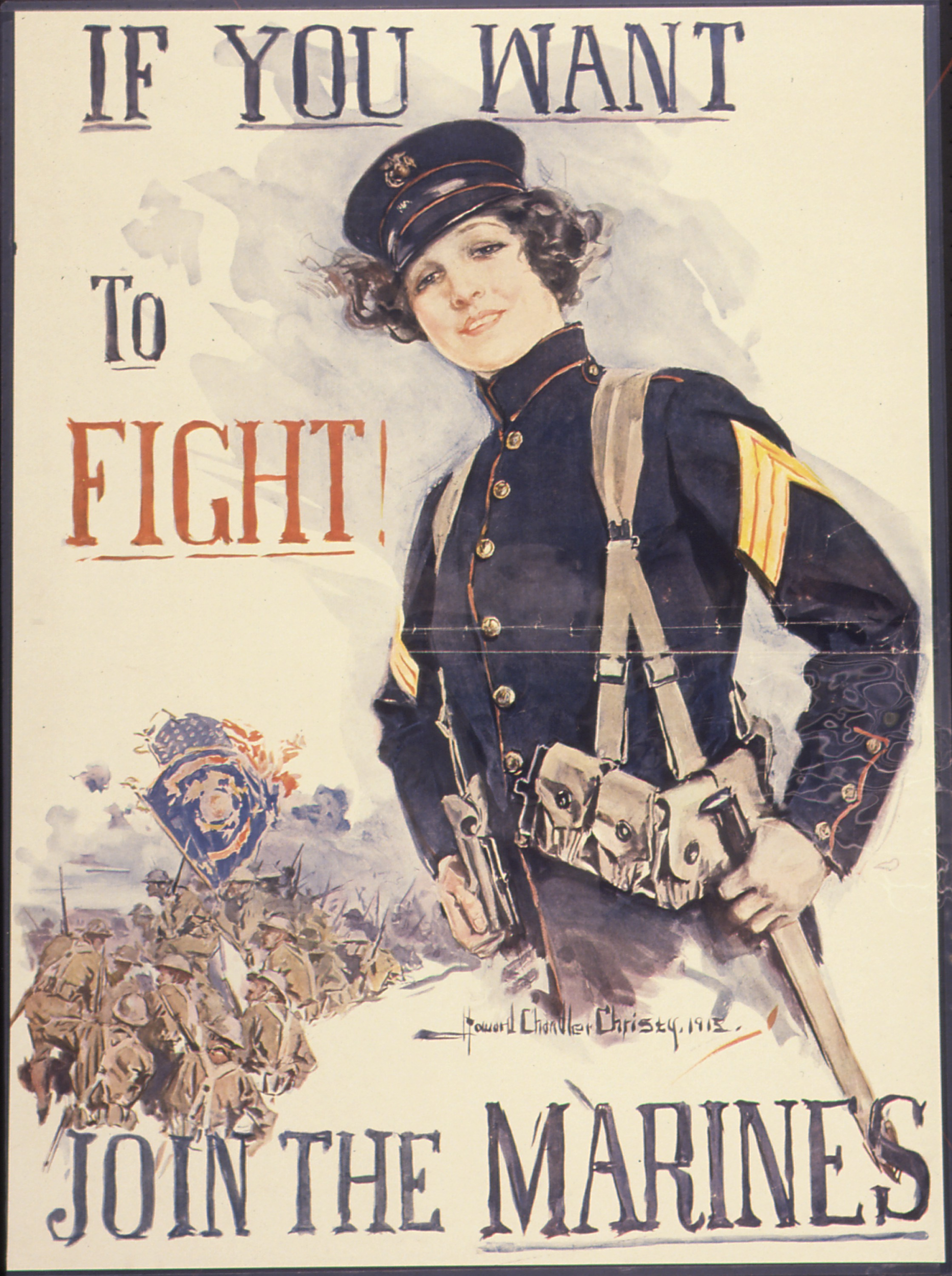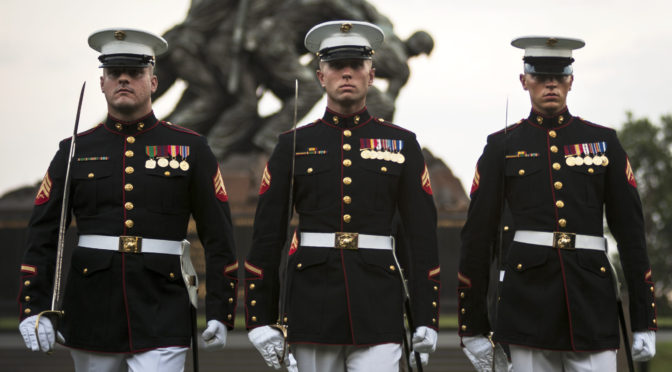By CDR Christopher Nelson, USN
Professor Heather Venable joined me to discuss her new book, How the Few Became the Proud: Crafting the Marine Corps Mystique, 1874-1918. It is a fascinating look at how the U.S. Marine Corps, struggling to define its role as a small fighting force in the earlier days of the republic, crafted a reputation and truly — a mystique — to ensure the service’s survival.
Heather, if we could, I’d like to begin with the title of your new book, How the Few Became the Proud. I certainly recall the Marine Corps recruiting commercials from the 1980s. Some were on the TV, and some were run in movie theaters. And of course, the commercials ended with the same tagline: “The Few, the Proud, the Marines.” Who came up with that phrase?
Venable: “The Few, the Proud” slogan actually came out in the 1970s, coined by J. Walter Thompson, the Marine Corps’ ad agency. One slogan that a Marine coined during the span of my research, though, is “once a Marine, always a Marine.” The first reference I’ve found to this slogan occurred in about 1907, the invention of a creative recruiting officer. Recruiting officers had practical reasons for coining such a phrase—they really wanted former Marines to continue to identify with the Corps in order to encourage future Marines in their local communities to enlist. But it also marks a broader and intensifying effort to get all Marines to identify more actively and positively with their institution that really increased prior to World War I.
What surprised me a bit was not that the Marine Corps was good at advertising, but how early and aggressively they advertised the Corps. And this was in the age before the big New York City advertisers, correct?
Venable: A fundamental transformation occurred in American society between the Civil War and World War I in terms of what society deemed acceptable in regard to marketing. Before, if you wanted to sell oranges, for example, it was not polite to say something like, “We have the biggest, juiciest oranges of all the competitors.” Rather, you said something like, “A new shipment of oranges have arrived. Come get a dozen for 5 cents.” So some nineteenth-century Marines wanted to brag about their Corps, but they believed it to be impolite. When these sentiments began shifting in society as a whole, Marines seized the initiative and began actively promoting the Corps, largely without any interaction with the professional advertisers.
Of all the commercials — the one where the Marine slays the dragon is the most memorable to me — but I also remember the commercial with the knight turning into the Marine. Apparently there’s even a ranking of all Marine commercials. Do you have a particular favorite? Is there a consistent theme in this advertising that goes back to the 19th century?
Venable: I love the knight commercial as well. I don’t see a consistent theme going back to the nineteenth century. But I do see links between the idealism of Marines—especially recruiters—that really began solidifying prior to World War I. And there is a chivalry celebrated and a love for a brotherhood (and it was, at this point, a brotherhood solely) that echoes in the Corps’ most compelling commercials. Whereas the Army has tried many different approaches, the Corps has stuck more consistently with the idea of serving for the sake of serving. It could be argued that those knight commercials of the 1980s were even more idealistic than their predecessors, the early twentieth-century recruiting posters. (An interesting outlier to this general trend is this commercial from the 1970s.)
In your book, you say that the Marines, early in their history, referred to themselves as soldiers. It’s how they described themselves to others. But that changes over time. How and when did that change take place?
Venable: It still had not taken place fully by the end of World War I, which I was surprised to find. In World War I memoirs written by Marines, for example, I noticed how it was more natural for most Marines to refer to themselves as soldiers more frequently than Marines. Thus individual Marines who enlisted during the war did not buy as fully into the rhetoric as longer-serving Marines. But in terms of representing themselves to the public, Marines had solved the essential problem of making it mean something to be a Marine where they did not necessarily have to explain what a Marine was, which had been a problem for decades.
You end the story, as your subtitle notes, around 1918. If you had more time and space, what is the biggest addition to this story? Does the mystique build through Korea?
Venable: I would want to talk about the idea of every Marine being a rifleman, because I think that is a key addition to the Corps’ identity that I did not see in the time period I researched. I assume that as the Corps increasingly professionalized and evolved after World War I, it differentiated its roles and specialties, thus necessitating some adjustment to seek to keep the overall institutional culture cohesive.
And how was the mystique challenged in Vietnam? Obviously, it survived that war. Any thoughts on how it did so?
Venable: Amidst the recent social distancing and a lot of seniors in high school having to miss proms and graduations and other celebrations, I saw someone post on social media something like, “Imagine graduating from high school and knowing you were going to Vietnam.” My dad went to college for a few years before he enlisted in the Corps, so he didn’t have that exact experience, but I can still appreciate the intense feelings provoked by knowing what they would soon be doing overseas. And, like my dad, many of them chose to serve in the Corps rather than get drafted into the Army. You see the same kind of sentiments within the World War I timeframe. You want to serve alongside and with those people you perceive to be the best for a whole host of reasons. And, as long as the institution has leaders at all levels who uphold the institution’s most positive traits of identity and leadership, you’re going to do better no matter the state of social upheaval. In World War I, many Marines were disappointed by some of their leaders. I would assume that this same reaction factored into the experiences of Vietnam Marines.
I want to move on to a chapter you wrote titled “Hypermasculinization.” What are you tackling in that chapter? And was the USMC (and is it still) disposed to hypermasculinization over the other U.S. military services?
Venable: I really wanted to understand some of the rhetoric produced by the first female Marines that did not make sense to me initially. They really undercut their own service. Everything fell into place for me when I realized that the first female Marines had not actually freed male Marines to fight. Indeed, those male Marines had already been declared unfit for overseas service. So the Corps’ reaction to this, I think, was similar to the impetus behind “every Marine a rifleman.” The greatest contribution of the first female Marines was ironically strengthening the Corps’ masculine identity by promoting the idea that all male Marines were fighters and female Marines were there to support them with clerical and other types of work.
I am absolutely convinced that the Corps is still the most hypermasculine of all the services. In talking to Army officers as long as a decade ago, I have been surprised how much more open they were to incorporating women into combat than men.
And the current Commandant seemed to fall into that tradition based on some comments he made last summer. Since then, though, he has taken some steps in the right direction that, frankly, have surprised me positively in regard to integrating training, because I agree with the argument that if you don’t integrate Marines from the very beginning, you can’t ever really integrate them if women aren’t visibly present during foundational experiences like the Crucible. I’m also excited to see major improvements on the Marine Corps’ website that was pretty disheartening about six months ago in the marked absence of females on the site.
Would you discuss the artist Chandler Christy’s famous recruiting poster — and how does it tie into that chapter?
Venable: I find it interesting that depictions of women in Marine uniforms tend to be more complex than women in Navy uniforms, at least around the World War I timeframe. The Chandler Christy poster features a woman dressed in a naval uniform as a simpering, flirtatious creature, intended to convey to a man that she is clearly not capable of military service, but he is. Thus images of women wearing Navy uniforms tended to avoid depictions of combat, like most of the Navy’s recruiting imagery at the time. But the Corps’ imagery is more complex and, indeed, conflicted. So a poster like “If You Want to Fight, Join the Marines” has some edgy elements to include a woman with her hand on a weapon, unlike the competing Chandler Christy poster for the Navy. But the Corps poses a more forthright challenge to potential recruits, asking them not just to “join” like the Navy but to “fight” and to consider why a woman is wearing a uniform and holding a bayonet but they aren’t.

Heather, last question, is Jack Nicholson in A Few Good Men overrated or underrated? Regardless, I think Aaron Sorkin nailed that script.
Venable: Great question. I think that Jack Nicholson appeared to be even more extreme than the characters in something like The Great Santini. I’ve been privileged to meet many Marines in my life, and none of them has been that extreme in personality. And so he was too stereotypical. Marines are normal people, not caricatures. Sorkin stressed the “warrior” aspect of the Corps’ legacy, not its highly idealistic vein captured so well in those 1980s commercials. So Nicholson’s character is overrated because he’s not subtle enough and certainly not human enough. And that’s consistent with the perceived warrior culture in the U.S. military as a whole that has really taken hold over the last few decades. It’s too simplistic and neglects the whole person.
Heather Venable is an associate professor of military and security studies in the Department of Airpower at the United States Air Force’s Air Command and Staff College. As a visiting professor at the U.S. Naval Academy, she taught naval and Marine Corps history. She received her Ph.D. in military history from Duke University. The views here are her own and do not necessarily reflect those of the U.S. Air Force, the Command and Staff College, or the U.S. Department of Defense. You can follow her on Twitter @Heather_at_ACTS and Linkedin.
Commander Christopher Nelson is the Deputy Senior Naval Intelligence Manager for East Asia in the Office of Naval Intelligence in Suitland, Maryland. He is a naval intelligence officer and graduate of the U.S. Naval War College and the Maritime Advanced Warfighting School in Newport, Rhode Island. The views here are his own and do not necessarily reflect those of the U.S. Navy or the U.S. Department of Defense.
Featured Image: Three noncommissioned officers from Marine Barracks, Washington at 8th & I, perform during a Tuesday Sunset Parade at the Marine Corps War Memorial in Arlington, Va., July 30, 2013. (Marine Corps photo by Lance Cpl. Dan Hosack/Released)


